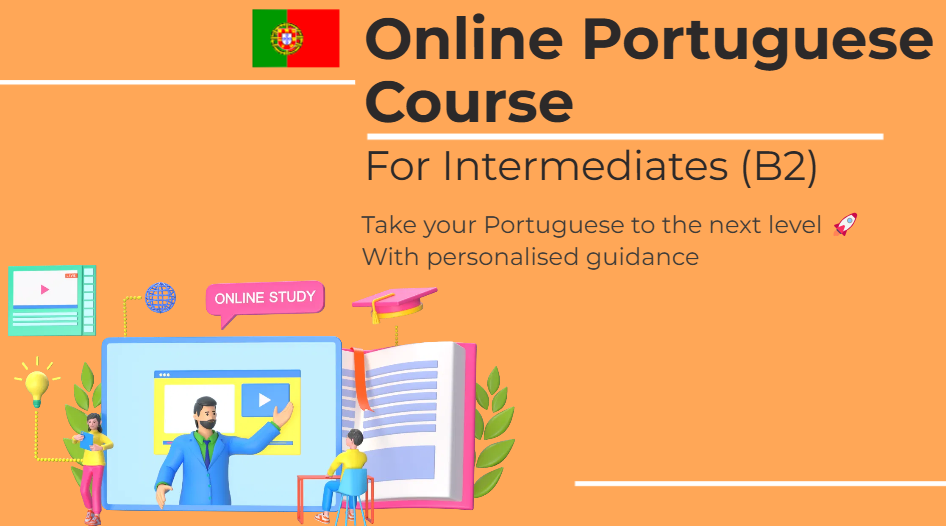Course Overview
European Portuguese B2
Overview
The course aims to enable students to develop communication, interaction, production, and comprehension skills for oral and written texts of medium and high complexity. Students will develop greater fluency when communicating in everyday or work situations, in formal and informal written or oral registers.
Objectives
That the student achieves:
- Write and understand emails and texts related to daily life and work;
- Interact normally with native speakers through clear and detailed presentations on a wide variety of topics presented in this course;
- Express opinions and defend points of view;
- Express oneself and write correctly using a variety of vocabulary on various topics of general interest.
Syllabus
- Unidade 1: Course presentation. Review of grammatical contents: verb tenses; direct and indirect speech; active and passive voice.
- Unidade 2: Review of grammatical contents: clitic pronouns; indefinite pronouns and prepositions.
- Unidade 3: Indicative and subjunctive moods. Verbs in the present subjunctive. Formation of regular and irregular verbs. Present subjunctive with impersonal constructions. Infinitive sentences and subjunctive sentences with impersonal constructions. Express an eventual action in the future.
- Unidade 4: Verbs in the present subjunctive. Verbs expressing desire, feeling, order, doubt, etc. Expressions of feeling, desire, and wish (ter medo de que / ter pena de que / ter vontade de que). Prepositions with verbal and nominal government. Formation of the feminine.
- Unidade 5: Verbs in the present subjunctive. Adverbs: talvez, se calhar, provavelmente. Concessive conjunctions. Infinitive sentences and subjunctive sentences expressing the idea of concession. Knowing how to ask for or give information. Describing sequences of actions.
- Unidade 6: Verbs in the present subjunctive. Temporal and final conjunctions. Infinitive sentences and conjunctive sentences expressing the notion of time and purpose. Há quem + Subjunctive / Há + noun + que + Indicative.
- Unidade 7: Verbs in the present subjunctive. Conditional conjunctions. Infinitive and conjunctive sentences expressing the notion of condition. Verbs of opinion and expressions of certainty in affirmative and negative forms (pensar que, dizer que, acreditar que, crer que).
- Unidade 8: Verbs in the present subjunctive. Unreal relative sentences. Indicative and subjunctive moods. Exclamatory sentences of desire.
- Unidade 9: Verbs in the present subjunctive. Concessive sentences with expressions of intensity (por muito que, onde quer que, quer…quer…). Consecutive sentences.
- Unidade 10: Verbs in the imperfect subjunctive. Formation of verb forms. Use of the imperfect subjunctive in impersonal constructions. Conditional sentences with the conjunction se.
- Unidade 11: Verbs in the imperfect subjunctive. Doubtful sentences: talvez. Completive sentences. Sentences with conjunctions. Relative sentences of eventuality. Unreal comparative structures. The comparison. Exclamatory sentences of desire. Present and imperfect subjunctive.
- Unidade 12: Verbs in the future subjunctive. Formation. Conditional sentences with the conjunction se. Conditional sentences with imperfect subjunctive or future subjunctive. Future subjunctive with relative sentences and comparative conjunctions. Future subjunctive with comparative sentences with como and conforme.
- Unidade 13: Verbs in the future subjunctive. Temporal sentences. Concessive sentences with verb repetition. Mesoclitic pronominal conjugation with future imperfect indicative and conditional.
- Unidade 14: Direct and indirect speech. Simple and compound personal infinitive. Proportional adverbial subordinate sentences. Emphatic sentences and topicalization (use of é que, the verb ser, and personal pronouns as circumstantial complements preceded by the preposition a). Causal subjunctive conjunctions and locutions.
- Unidade 15: General review of the subjunctive mood. Text comprehension and production.
Additional information
Teaching-Learning methodology
This course is delivered online within the DAC Learning Virtual Campus. The study material includes pre-recorded lessons with a teacher, practical exercises, and may feature additional videos and audio. The course requires you to do exercises using text files (Word, Docs, etc.). We recommend using Google or Microsoft email accounts to copy the files. The activities will be corrected by a tutor and you will have feedback in approximately one week.
Course access: 150 days from the date of purchase.
Bibliography
- Carla Oliveira. Luísa Coelho. (2013). Aprender português 3. Português para estrangeiros. Nível B2. Editorial Texto Editores.
- Teresa S. Ferreira. Inês Cardoso. Sílvia Melo-Pfeifer. (2020). Gramática Português Língua Não Materna. Níveis B1, B2 e C1. Editorial Porto Editora.
- Sitios de referencia: «dicionario.priberam.org»,«ciberduvidas.iscte-iul.pt», «https://www.infopedia.pt/dicionarios/verbos-portugueses/».
